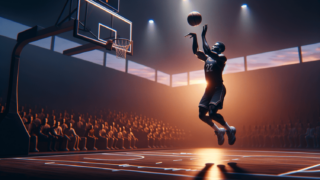
How to Improve Your Free Throw Shooting in Basketball?
Written by: Basketball Universe
Last updated:

When it comes to basketball, there’s nothing quite as satisfying as watching your free throw swish through the net, scoring an effortless point for your team. But let’s face it, perfecting your free throw shooting is no simple feat. Whether you’re a seasoned pro or an enthusiastic newbie, this blog post is tailored just for you. Combining expert techniques, practical tips, and the secrets of the most successful shooters, we’ll navigate through the intricacies of becoming a free throw maestro. Get ready to elevate your game and witness a remarkable improvement in your free throw shooting!
How to Improve Your Free Throw Shooting in Basketball?
To improve your free throw shooting, focus on refining your technique and maintaining consistency. First, ensure proper body alignment—aim to have your feet shoulder-width apart, your shooting foot slightly ahead, and your hips and shoulders square to the basket. Hold the ball with both hands and the fingers of your shooting hand spread out, while positioning the ball’s air valve between your index and middle finger. Balance the ball on the pads of your fingers, with the non-shooting hand offering support. As you shoot, maintain a straight arm and wrist motion, and use your legs to generate force. Practice frequently, stay relaxed and develop a pre-shot routine to ensure consistency and build muscle memory.
Understanding the Science of Free Throw Shooting
Before diving into practical tips for improving your free throw shooting, it’s crucial to comprehend the science behind it. By grasping the mechanics of a successful free throw shot, you’ll be better equipped to implement various techniques and recognize areas needing improvement. Now, let’s take a closer look at these components, which include balance, posture, focus, release, and follow-through.
Balance
Every great free throw begins with impeccable balance. By establishing a solid foundation, you’ll be poised to execute a shot with consistency and accuracy. Balance starts from the ground up—ensure that your feet are shoulder-width apart and firmly planted on the floor. Your shooting foot should be slightly forward, with your knees slightly bent.Pay close attention to your body’s center of gravity. The energy for your free throw begins at your feet and flows up through your core. If your body is misaligned, it throws off your shot, leading to missed baskets. By maintaining your balance throughout the entire motion, you’ll significantly improve your free throw shooting outcomes.
Posture
Posture plays a pivotal role in ensuring efficient energy transfer from your lower body to your shooting hand. For optimal results, align your hips and shoulders square to the basket. Keep your chest up, and tuck in your elbows to maintain a straight shooting line.A good way to gauge your posture is to have someone take a video or snap a photo of your stance from different angles. Comparing your posture to those of professional basketball players may help you identify areas that need tweaking. Developing a consistent, correct posture will undeniably improve your free throw shooting.
Mastering the Perfect Free Throw Grip
An effective grip is essential for controlling the ball on your free throw shots. Adopting the correct grip not only ensures better accuracy and precision but also builds confidence, enabling you to nail those crucial shots during the game. Let’s take a look at some key points to consider for an impeccable grip:
Proper Hand Placement
Place the ball in the fingertips of your shooting hand, with your fingers spread wide enough to deliver maximum surface area for better control. Keep a small gap between the palm of your shooting hand and the ball to ensure a smooth, accurate release.The non-shooting hand should support the side of the ball without influencing its course. Thinking of it as a “guide hand” helps prevent overuse in the shooting process.
The Importance of Fingers
Experts often advise positioning the air valve of the ball between your index and middle fingers of the shooting hand. Doing so improves consistency in shot alignment and generates proper backspin on the release.Upon releasing the ball, maintain a “gooseneck” position with your fingers pointing towards the floor and slightly spread. This finger placement and follow-through will significantly contribute to your shot’s accuracy and consistency.
Developing a Consistent Shooting Routine
To attain mastery in free throw shooting, consistency is key. Top basketball players have rituals they stick to every time they step up to the free throw line. Whether it’s a specific dribbling pattern, deep breaths, or any other sequence, this pre-shot routine helps calm nerves, improves focus, and facilitates muscle memory. Let’s dive into the vital aspects of building a consistent shooting routine:
Find Your Rhythm
Establish a short, pre-shot routine that you can follow during practice and games. This sequence should be simple enough to execute under pressure and mentally prepare you for the shot.Some popular routines include bouncing the ball a specific number of times, exhaling deeply, or rotating the ball in your hands. Stick with your chosen pattern and repeat this every time you attempt a free throw, as it aids in building muscle memory and provides a sense of comfort before shooting.
Practice Regularly
Regular practice of your free throw shooting is indispensable to achieving desired results. Allocate a section of each practice session to free throws, and track your performance over time. This data will help identify weaknesses and progress, motivating you to consistently improve.Increase the challenge of your practice by including pressure situations, such as trying to hit consecutive free throws, shooting after sprints, or attempting shots with external distractions. Devising a practice routine that replicates game-like pressures will significantly enhance your free throw shooting performance during crucial moments in basketball games.
Employing Mental Strategies for Better Free Throws
While physical aspects, such as technique and muscle memory, contribute significantly to your free throw shooting success, the mental side of things should never be underestimated. Given that free throws often arise during high-pressure situations, it’s crucial to develop a strong mental framework that fosters confidence, focus, and self-belief. Here are some mental strategies to integrate into your free throw shooting:
Visualization
Visualization involves mentally rehearsing your free throws in your mind. Close your eyes and imagine stepping up to the line, executing your pre-shot routine, and effortlessly swishing the ball through the net. Visualizing successful shots helps build your self-assurance and yields improved outcomes on the court.Integrating visualization into your daily routine, particularly before practice or games, conditions your mind for success and reinforces muscle memory.
Breathing Techniques
Proper breathing is vital to remaining calm and centered on the basketball court. Deep, controlled breaths help slow your heart rate, relax muscles, and increase focus. Integrating deep-breathing exercises into your pre-shot routine is a simple, effective way to ensure mental clarity and composure.Try inhaling through your nose for four counts, holding your breath for four counts, and exhaling slowly through your mouth for six counts. Repeating this process will provide a sense of tranquility and better equip you for executing the perfect shot.
Putting It All Together: Shooting Drills and Feedback
Now that you’ve got an understanding of the mechanics, grip, shooting routine, and mental strategies for better free throw shooting, it’s time to put it all into practice. The following shooting drills and methods for receiving feedback will aid in your journey to becoming a free throw shooting expert.
Incorporate Shooting Drills
Implement basketball-specific shooting drills into your practice routine to hone your free throw skills. Some drills to consider include *
Analyzing and Emulating the Greats
One beneficial strategy for improving your free throw shooting is to analyze the techniques of successful professional basketball players. These athletes have dedicated countless hours to honing their craft, and their tried-and-tested methods can be a treasure trove of knowledge for aspiring basketball enthusiasts. Observe their posture, grip, follow-through, and pre-shot rituals. Take note of the unique nuances that differentiate their free throw styles and experiment with integrating these subtle adjustments into your practice routine.
The Role of Strength and Conditioning
While free throw shooting relies heavily on technique, having an ideal strength and conditioning regimen can contribute to improved overall performance. Strengthening your leg muscles ensures a stable base and enables more efficient energy transfer from the ground up. Simple exercises such as squats, lunges, and calf raises can be added to your regular workouts to target these areas.Furthermore, training your core muscles—including your abdominals, lower back, and obliques—provides enhanced stability and balance during free throw shooting. Implement core-focused exercises such as planks, leg raises, and Russian twists for a comprehensive workout aimed at improving on-court performance.
Using Video Analysis to Fine-Tune Your Technique
An invaluable tool for assessing your technique and identifying areas for improvement is video analysis. Film your free throw shooting from different angles during practice sessions or games to gain detailed insights into your performance.Review the footage at different speeds—use slow motion to scrutinize your mechanics and technique, and determine which aspects require modification. Moreover, you can use video analysis to monitor your progress and ensure consistency in your shooting ritual. Sharing your recordings with fellow players or coaches can also garner additional feedback and advice, making video analysis an indispensable resource for aspiring free throw shooters.
Overcoming Performance Anxiety and Pressure
Free throw shooting often occurs during high-stress situations, so learning to cope with anxiety and pressure can significantly bolster your success rate. To acclimate to these tense moments, consider including “pressure training” in your practice sessions.Simulate game-like intensity by asking teammates to yell or create distractions while you shoot. Another effective method is to make free throw accuracy the deciding factor in competitive practice scenarios—for example, assign free throw shooting as the method to break a tie or finalize practice. By incorporating these high-pressure exercises into your routine, you’ll develop the mental fortitude needed to excel during actual basketball games.
Building a Coachable Mindset
A coachable mindset is essential for any athlete seeking to refine their skills. As you endeavor to improve your free throw shooting, remain open to feedback from teammates, coaches, and experts alike. Actively solicit advice and apply the constructive criticism to better your performance.Remember that improvement requires patience and persistence—occasional setbacks are normal. Staying dedicated to your goals and maintaining a positive, coachable attitude will undoubtedly contribute to your development as a proficient free throw shooter in basketball.
Frequently Asked Questions: Free Throw Shooting in Basketball
If you’re striving to boost your free throw shooting skills, you’re bound to have questions on this essential aspect of the game. We’re here to help, providing answers to 10 common questions related to free throw shooting, so you can make informed decisions and become the best player possible.
1. What is a good free throw shooting percentage?
A good free throw shooting percentage generally falls within the 70%-80% range. Elite professional basketball players typically achieve percentages of 85% or higher.
2. How can I increase my shooting range in basketball?
To increase your shooting range, focus on enhancing leg and core strength, refining shooting mechanics, and progressively practicing from further distances. Incorporate strength and conditioning exercises into your routine, and gradually push shooting boundaries during practice.
3. How important is follow-through in free throw shooting?
Follow-through is vital in free throw shooting, as it impacts the ball’s trajectory, spin, and accuracy. A proper follow-through involves extending your shooting arm completely and maintaining a “gooseneck” position with your fingers pointing towards the floor and slightly spread.
4. How can I practice free throw shooting at home without a basketball court?
While having access to a basketball court is ideal, you can still practice at home by focusing on shooting form, grip, and balance. Perform shadow-shooting drills and visualize successful free throws. Strength and conditioning exercises can also be incorporated into your at-home routine.
5. How do I stay calm during pressure-filled free throw situations?
Utilize deep breathing techniques, visualization, and positive self-talk to maintain composure during high-pressure free throw situations. Regularly simulate pressure in your practice sessions to become accustomed to staying calm under stress.
6. Can I change my free throw shooting technique midway through the season?
You can change your free throw shooting technique, but doing so requires consistent practice and patience. It’s essential to adhere to the new technique, consciously work on making adjustments, and allow adequate time for muscle memory development.
7. What can I learn from watching other players shoot free throws?
Observing other players’ free throw shooting can reveal useful techniques, grips, and follow-through methods. You can gather insights into individual nuances and apply these adjustments to your practice routine for potential improvement.
8. What is BEEF in free throw shooting?
BEEF stands for Balance, Eyes, Elbow, and Follow-through. It is an acronym that helps simplify the critical elements of a successful free throw shot, serving as an easy reminder for players to focus on these aspects.
9. Should I practice free throw shooting at the beginning or end of my training sessions?
Integrating free throw shooting practice throughout your training session is best. Begin your session with relaxed, focused shooting; then practice free throws during high-pressure or fatigue-inducing scenarios; and finish with additional concentrated shooting to improve consistency.
10. How much time should I dedicate to free throw shooting practice?
There’s no set amount of time, but ensuring a portion of each practice session is dedicated to free throws is crucial. Aim for a mixture of regular, focused practice and game-like scenarios to foster comprehensive free throw shooting development.
Featured Posts
- No pillar pages found.





